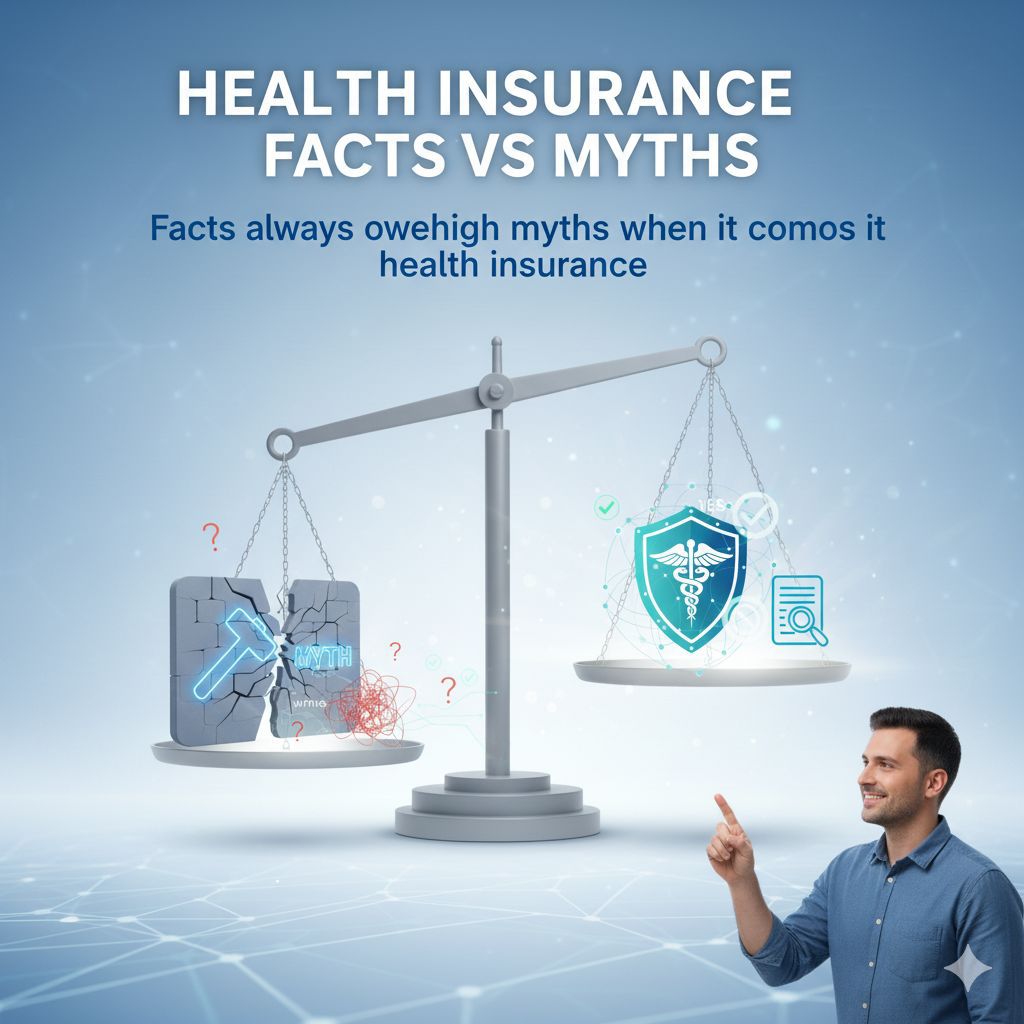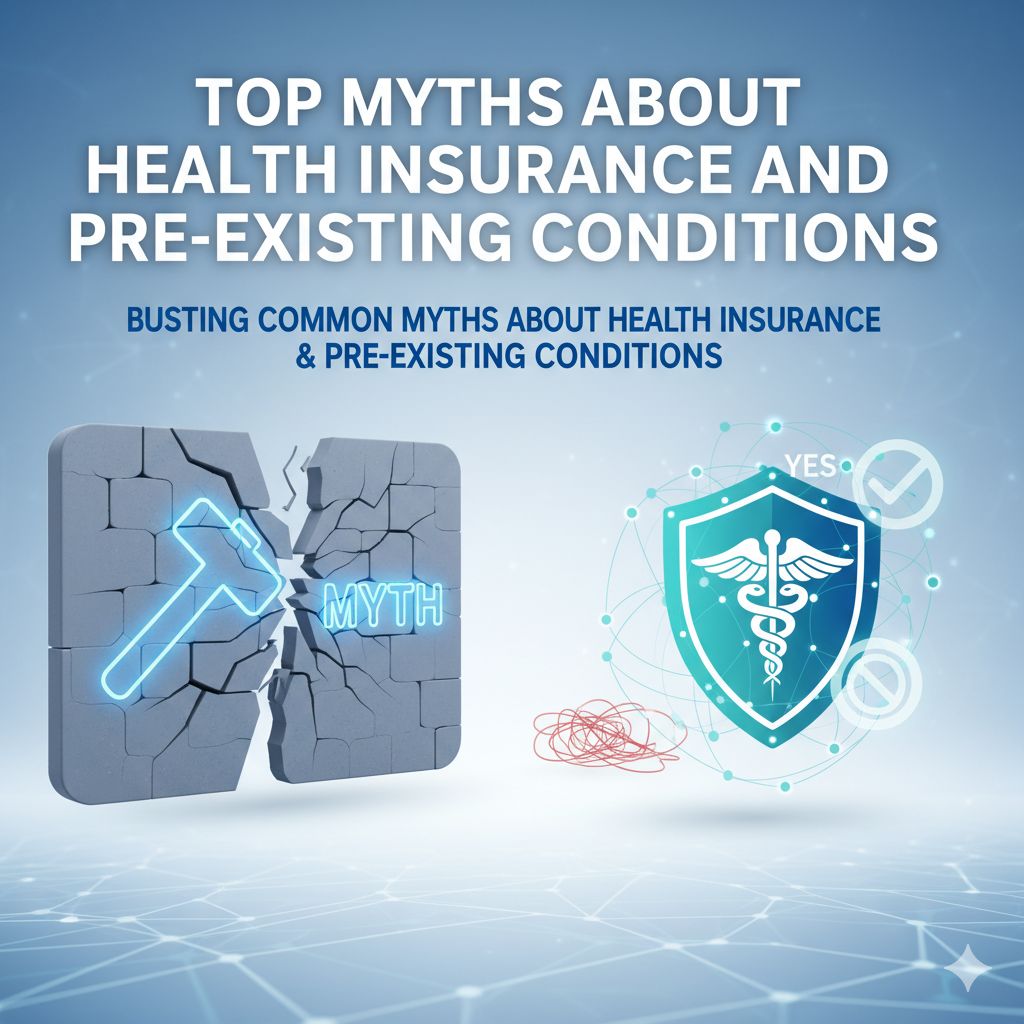In this detailed guide, we’ll bust the 5 most common myths with facts, examples, and expert-backed insights. By the end, you’ll feel confident in making better choices for yourself and your loved ones—without letting myths hold you back.
Why Do Myths Around Health Insurance Exist?
Healthcare is complex. Insurance documents are often written in legal or technical jargon that makes it hard for an average policyholder like you to interpret correctly. Add in word-of-mouth stories from friends, sensational headlines, or even outdated policies that no longer exist, and you end up with myths that sound believable but aren’t true today. Unfortunately, myths can cost you thousands of rupees or dollars in uncovered expenses and can even prevent timely treatment.
Before we dive into each myth, let’s first define what counts as a pre-existing condition. A pre-existing condition refers to any illness, injury, or health issue that you already had before applying for health insurance. This can range from lifestyle diseases like diabetes to long-term issues like heart conditions, thyroid disorders, or even past surgeries. Now that we’re clear on the term, let’s get myth-busting.
Myth 1: Pre-existing Conditions Are Never Covered
This is perhaps the most widespread misconception. Many people believe that once you’ve been diagnosed with a health issue, no insurance company will take you on board. But the truth is much more reassuring. Modern health insurance policies do cover pre-existing conditions, though usually after a waiting period of 2 to 4 years. During this period, claims related to those conditions may not be accepted, but once it ends, you enjoy full coverage.
Case Example: Rina, a 40-year-old working professional with Type 2 diabetes, hesitated to buy insurance because she thought no company would cover her. After consulting with a licensed agent, she found a policy with a 3-year waiting period for diabetes-related claims. Three years later, when she required hospitalization due to a diabetes complication, her policy paid for the majority of her expenses. If she had waited any longer, she would have paid entirely out-of-pocket.
Fact: Don’t assume exclusion means permanent denial. Insurers want to offer coverage but must protect themselves from immediate high-risk payouts. Waiting periods balance the needs of both sides.
Myth 2: Declaring a Pre-existing Condition Will Lead to Rejection
Another common myth is that honesty about your health history will automatically lead to rejection. Many people avoid disclosing their conditions, hoping insurers “won’t find out.” But here’s the reality: insurers usually require medical tests, and even if something is missed at the start, it will show up when you file a claim. Concealing conditions can lead to claim denial later, which is far more painful than being upfront.

Real Story: A 52-year-old man in Delhi applied for health insurance without disclosing his past cardiac surgery. When he later filed a claim for heart-related treatment, the insurer investigated and found the hidden condition. The claim was rejected, and his entire hospital bill had to be paid out-of-pocket. The stress and financial loss were far greater than if he had declared it honestly at the start.
Fact: Insurers don’t want to reject applications unnecessarily. By declaring conditions upfront, you often get customized policies that protect you better. Transparency is your best safeguard.
Myth 3: Premiums Become Unaffordable with Pre-existing Conditions
It’s natural to think that a history of illness will push your premiums out of reach. While it’s true that insurers may charge slightly higher premiums for individuals with pre-existing conditions, these increases are not always as dramatic as people fear. Pricing depends on multiple factors: your age, the severity of your condition, your lifestyle habits (like smoking or drinking), and the sum insured.
Comparison Example: Raj, 45, with controlled hypertension, pays just 15% more than his friend of the same age who has no condition. The difference is significant but not unmanageable. When you consider the cost of a single hospitalization for a heart issue—which can exceed ₹3–5 lakhs in India—the extra premium feels like a smart investment.
Fact: Insurers spread risks across thousands of policyholders. That means your individual premium isn’t determined in isolation. With careful research, you can still find affordable plans that provide excellent protection.
Myth 4: Employer Health Insurance Is Enough
Relying solely on employer-provided insurance is a dangerous myth. While it’s convenient and often free or low-cost, employer policies usually have several limitations:
- Coverage may end when you switch jobs or retire.
- Pre-existing conditions may have caps or limited benefits.
- The sum insured may be too low (for example, ₹2–3 lakhs, which is insufficient for major surgeries).
Scenario: Meena, 50, depended entirely on her company’s health insurance. After retirement, she realized her coverage ended, and new policies for her age and medical history were far more expensive. Had she purchased an additional personal policy earlier, she would have enjoyed lifelong protection.
Fact: Your employer’s policy is a great bonus, but it should never be your only plan. Personal policies ensure continuity, higher sums insured, and more comprehensive coverage.
Myth 5: Once Covered, You Don’t Need to Review Your Policy
Health insurance is not a “set it and forget it” product. Medical technology evolves, treatment costs rise, and new policies with better benefits enter the market. If you don’t review your coverage regularly, you may find your policy outdated when you need it most.
Example: Arun bought a policy in 2010 with a sum insured of ₹2 lakhs. By 2023, the cost of a single angioplasty had risen to nearly ₹4–5 lakhs. His outdated policy covered only a fraction of the cost. Had he reviewed and upgraded earlier, he would have been far better prepared.
Fact: Treat your insurance policy like an evolving financial tool. Review it every 2–3 years to ensure it matches your family’s needs and today’s medical costs.
What You Should Do Instead of Believing Myths
Now that we’ve debunked the five most common myths, here are practical steps you can take:
- Read Carefully: Go through policy documents, focusing on waiting periods, exclusions, and renewal terms.
- Declare Honestly: Never hide pre-existing conditions. Transparency prevents claim rejection.
- Compare Wisely: Use online comparison tools and consult agents to find the best balance of premium and coverage.
- Supplement Coverage: Add riders like critical illness or top-up policies to strengthen your protection.
- Review Regularly: Update your policy every few years to match inflation and medical advances.
Expert Insights and Regulatory Guidelines
To stay informed, refer to trusted sources like the World Health Organization’s page on universal health coverage and the Insurance Regulatory and Development Authority of India (IRDAI). Both provide global and national perspectives on healthcare and insurance practices, ensuring that you don’t fall for outdated information.
You can also check our in-depth guides such as Guide to Choosing the Best Health Insurance Plan and Top Financial Mistakes to Avoid in Healthcare Planning for additional insights.

Conclusion
By busting these myths about health insurance and pre-existing conditions, you gain clarity and confidence. Instead of postponing coverage out of fear, take action with knowledge. Pre-existing conditions do not make you ineligible. They don’t always lead to rejection. Premiums are still manageable, employer plans aren’t enough, and policies need regular reviews. When you separate fact from fiction, you protect not only your finances but also your family’s peace of mind.
FAQs
1. Are pre-existing conditions covered in all health insurance policies?
Yes, but usually after a waiting period that varies between 2 to 4 years depending on the insurer.
2. Can insurers reject my claim if I hide my pre-existing condition?
Yes, hiding conditions may lead to rejection. Always declare your medical history honestly.
3. Will my premiums always be very high with pre-existing conditions?
No, premiums may be slightly higher, but they remain manageable if you compare multiple plans.
4. Is employer-provided health insurance enough?
No, it may not be sufficient for long-term or pre-existing health needs. A personal policy is essential.
5. Do I need to review my policy even after waiting periods are over?
Yes, because medical costs rise, and new policies with better features become available.

